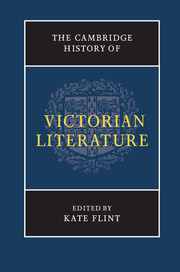Book contents
- Frontmatter
- Introduction
- PART I AUTHORS, READERS, AND PUBLISHERS
- PART II WRITING VICTORIA’s ENGLAND
- PART III MODES OF WRITING
- PART IV MATTERS OF DEBATE
- 15 Education
- 16 Spirituality
- 17 Material
- 18 Economics and finance
- 19 History
- 20 Sexuality
- 21 Aesthetics
- 22 Science and literature
- 23 Subjectivity, psychology, and the imagination
- 24 Cityscapes
- 25 The rural scene: Victorian literature and the natural world
- 26 ‘The annihilation of space and time’: literature and technology
- PART V SPACES OF WRITING
- PART VI VICTORIAN AFTERLIVES
- Select bibliography
- Index
17 - Material
from PART IV - MATTERS OF DEBATE
Published online by Cambridge University Press: 28 March 2012
- Frontmatter
- Introduction
- PART I AUTHORS, READERS, AND PUBLISHERS
- PART II WRITING VICTORIA’s ENGLAND
- PART III MODES OF WRITING
- PART IV MATTERS OF DEBATE
- 15 Education
- 16 Spirituality
- 17 Material
- 18 Economics and finance
- 19 History
- 20 Sexuality
- 21 Aesthetics
- 22 Science and literature
- 23 Subjectivity, psychology, and the imagination
- 24 Cityscapes
- 25 The rural scene: Victorian literature and the natural world
- 26 ‘The annihilation of space and time’: literature and technology
- PART V SPACES OF WRITING
- PART VI VICTORIAN AFTERLIVES
- Select bibliography
- Index
Summary
Manufactured calico, tea cups, dresses, pins, and forks flowing from the factories and workshops of the ‘great’ towns; imported sugar, coffee, tea, Madeira, silk, and diamonds arriving from the colonies and zones of ‘free trade’; handmade crafts fashioned by middle-class women and by William Morris; souvenir postcards and plates returning home from Blackpool, Skye, and the Alps; collections of butterflies, ferns, and cacti lovingly bought, gathered, and displayed by amateur and professional naturalists; rubbish and ‘dust’ piling up uncomfortably and often dangerously in streets and alleys: the material world of the Victorian period and its literature delights and daunts us in its variety and vastness. How do we read and interpret this array of stuff when we encounter it in the varied genres of Victorian literature? This chapter will enlarge on the possibilities that inhere in these questions, both as they pertain to modes of Victorian writing and to the way we read them now.
‘Even the humblest material artefact, which is the product and symbol of a particular civilization, is an emissary of the culture out of which it comes’, T. S. Eliot writes in Notes towards the Definition of Culture. This is one of the epigraphs of the historian Asa Briggs’s monumental Victorian Things and might be its credo as well. Briggs takes us on an incomparable tour of the Victorian object world: daguerreotypes, spectacles, matches, needles, bonnets, Staffordshire figures, medals, souvenir heads, hankies, penny postage stamps, and cookery books connect us to the people who made and bought and used them, to wars, laws, strikes, fashion, and gender roles, to ideas about home and hearth, many of which were invented by the Victorians and are still practised by us.
- Type
- Chapter
- Information
- The Cambridge History of Victorian Literature , pp. 370 - 387Publisher: Cambridge University PressPrint publication year: 2012



